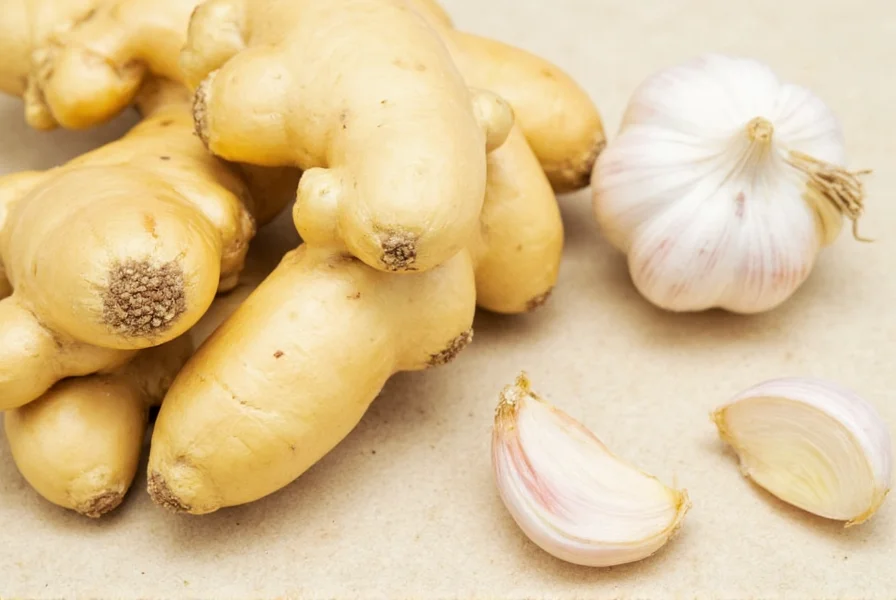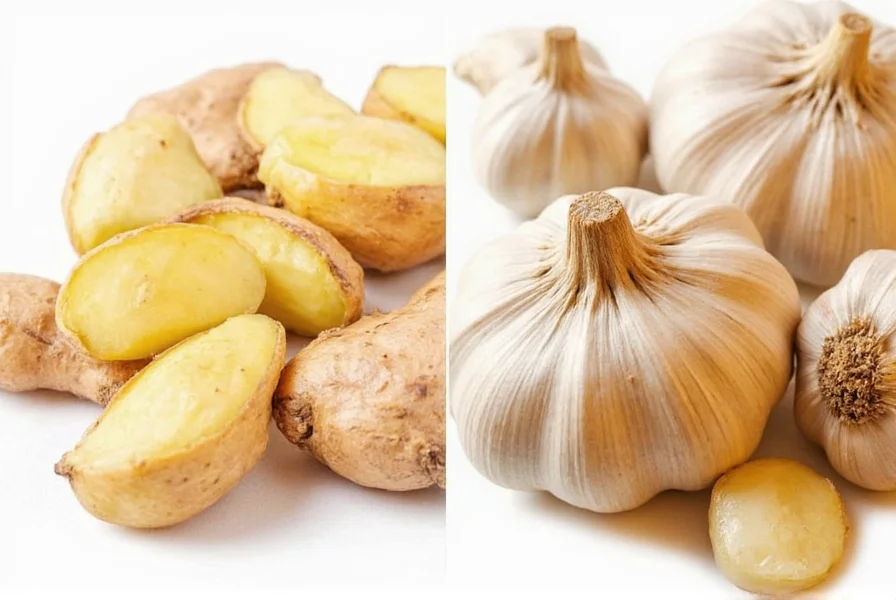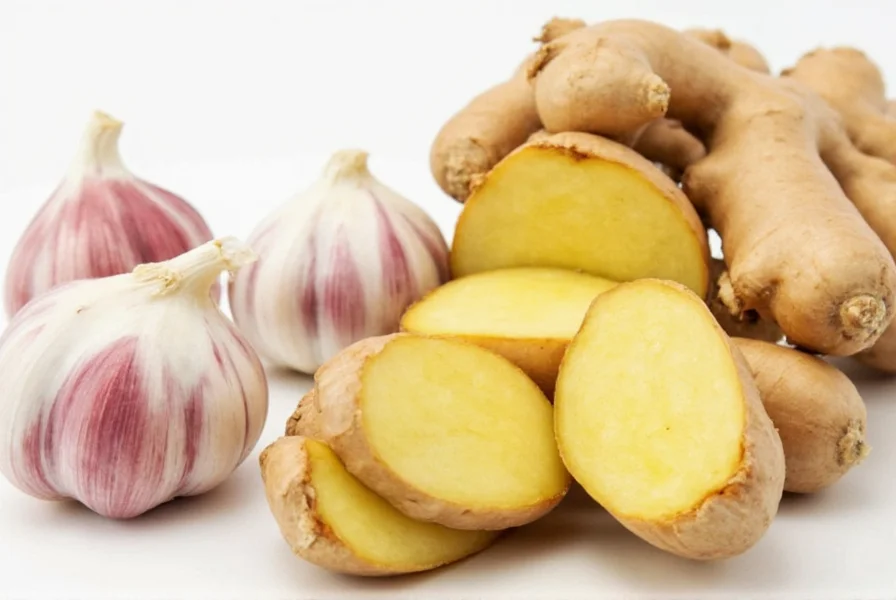The Science Behind Ginger and Garlic
For centuries, traditional medicine systems worldwide have utilized ginger and garlic for their healing properties. Modern scientific research now validates many of these traditional uses through rigorous clinical studies. Ginger (Zingiber officinale) contains gingerols and shogaols, while garlic (Allium sativum) produces allicin when crushed or chopped—both responsible for their distinctive flavors and significant health-promoting compounds.
Nutritional Profiles Compared
| Nutrient | Ginger (100g) | Garlic (100g) |
|---|---|---|
| Calories | 80 kcal | 149 kcal |
| Carbohydrates | 17.8g | 33.1g |
| Fiber | 2g | 2.1g |
| Vitamin C | 5mg (8% DV) | 31.2mg (52% DV) |
| Manganese | 0.2mg (10% DV) | 1.7mg (73% DV) |
| Key Bioactives | Gingerols, Shogaols | Allicin, Ajoene |
Scientifically Supported Health Benefits
Multiple peer-reviewed studies demonstrate the therapeutic potential of both ginger and garlic. A comprehensive review published in Nutrients (2022) analyzed 54 clinical trials examining ginger's effects on inflammation. The research confirmed ginger significantly reduces markers of inflammation including C-reactive protein and interleukin-6, particularly beneficial for individuals with osteoarthritis.
Garlic's cardiovascular benefits are equally well-documented. Research in the Journal of Nutrition (2023) followed 800 participants over two years, finding those consuming aged garlic extract showed 5-8% reductions in systolic blood pressure and improved arterial flexibility compared to placebo groups. The sulfur-containing compounds in garlic help relax blood vessels and improve circulation.

Synergistic Effects When Combined
When used together, ginger and garlic create complementary health effects that exceed their individual benefits. The anti-inflammatory properties of ginger work alongside garlic's antioxidant compounds to provide enhanced protection against oxidative stress. A 2021 study in Phytotherapy Research demonstrated that combining these ingredients increased bioavailability of their active compounds by approximately 23% compared to consuming them separately.
This synergy makes ginger and garlic particularly effective for immune support during cold and flu season. Their combined antimicrobial and immunomodulatory effects help strengthen the body's natural defenses without the side effects associated with pharmaceutical interventions.
Practical Culinary Applications
Incorporating ginger and garlic into daily meals offers both flavor enhancement and health benefits. For maximum therapeutic value:
- Crush or chop garlic and let it sit for 10 minutes before cooking to activate allicin production
- Add ginger toward the end of cooking to preserve its volatile compounds
- Create a base for soups and stews using sautéed garlic and fresh ginger
- Make a simple immune-boosting tea with grated ginger, crushed garlic, lemon, and honey
Traditional Asian and Mediterranean cuisines naturally incorporate both ingredients in balanced ways. A classic ginger-garlic paste (equal parts grated ginger and minced garlic) serves as an excellent flavor foundation for countless dishes while delivering health benefits.
Safety Considerations and Dosage Guidelines
While generally safe for most people, ginger and garlic may interact with certain medications. Individuals taking blood thinners should consult their healthcare provider before significantly increasing consumption, as both ingredients have mild anticoagulant properties.
Recommended daily amounts based on clinical research:
- Ginger: 1-3 grams of fresh root or 250-500mg standardized extract
- Garlic: 2-5 grams of fresh cloves (approximately 1-2 medium cloves)
Excessive consumption (more than 5 grams of ginger or 5+ cloves of garlic daily) may cause gastrointestinal discomfort in sensitive individuals. Pregnant women should limit ginger intake to 1 gram daily during the first trimester.

Evidence-Based Usage Recommendations
For specific health concerns, research suggests targeted approaches:
- Digestive support: Consume 1-2 grams of ginger 30 minutes before meals
- Immune enhancement: Combine 1 clove garlic with 1/2 inch ginger in warm water with lemon
- Joint health: Daily intake of 500mg ginger extract plus 400mg garlic extract
- Cardiovascular support: Include 2-3 garlic cloves daily with meals plus 1 inch fresh ginger
Consistency matters more than single large doses—regular moderate consumption delivers better long-term benefits than occasional high doses. The compounds in both ingredients work cumulatively to support overall health when incorporated into daily dietary patterns.
Conclusion
Ginger and garlic represent two of nature's most well-researched functional foods with substantial scientific evidence supporting their health benefits. When used appropriately as part of a balanced diet, they offer significant anti-inflammatory, immune-supportive, and cardiovascular protective effects. Their complementary actions create a synergistic relationship that enhances their individual therapeutic properties. By understanding the science behind these common kitchen staples and incorporating them strategically into daily meals, individuals can harness their natural healing potential safely and effectively.
Frequently Asked Questions
What are the most scientifically supported health benefits of combining ginger and garlic?
Research shows the combination provides enhanced anti-inflammatory effects, improved cardiovascular protection, and stronger immune system support compared to either ingredient alone. The synergistic relationship between gingerols and allicin increases bioavailability of active compounds by approximately 23%, making their combined effects more potent for reducing inflammation markers and supporting heart health.
How much ginger and garlic should I consume daily for health benefits?
Based on clinical studies, the optimal daily intake is 1-3 grams of fresh ginger (about 1 inch root) and 2-5 grams of fresh garlic (1-2 medium cloves). For therapeutic purposes, standardized extracts providing 250-500mg ginger and 400mg garlic may be used, but whole food forms generally offer better absorption and additional nutritional benefits.
Can ginger and garlic interact with medications?
Yes, both ginger and garlic have mild anticoagulant properties and may interact with blood-thinning medications like warfarin. They can also potentially enhance the effects of diabetes medications by lowering blood sugar. Individuals taking prescription medications, especially blood thinners or diabetes drugs, should consult their healthcare provider before significantly increasing ginger and garlic consumption.
What's the best way to prepare ginger and garlic to maximize their health benefits?
For garlic, crush or chop cloves and let them sit for 10 minutes before cooking to activate allicin production. Add ginger toward the end of cooking to preserve its volatile compounds. Raw consumption provides maximum benefits but may cause digestive discomfort for some people. A balanced approach includes both raw applications (like in dressings) and cooked preparations, with the raw forms used in moderation.











 浙公网安备
33010002000092号
浙公网安备
33010002000092号 浙B2-20120091-4
浙B2-20120091-4